21 Feb Timeless Hauz Khas
Delhi’s most scenic and historical quiet spot
More than any other place in Delhi, the unhurried pace of Hauz Khas offers a heady mix of history and scenery and solitude.
Hauz Khas has been pivotal to Delhi’s history for centuries, and its crumbling walls and an ageless madrassa have a thousand stories to tell. As the cliché goes, if only these walls could speak…
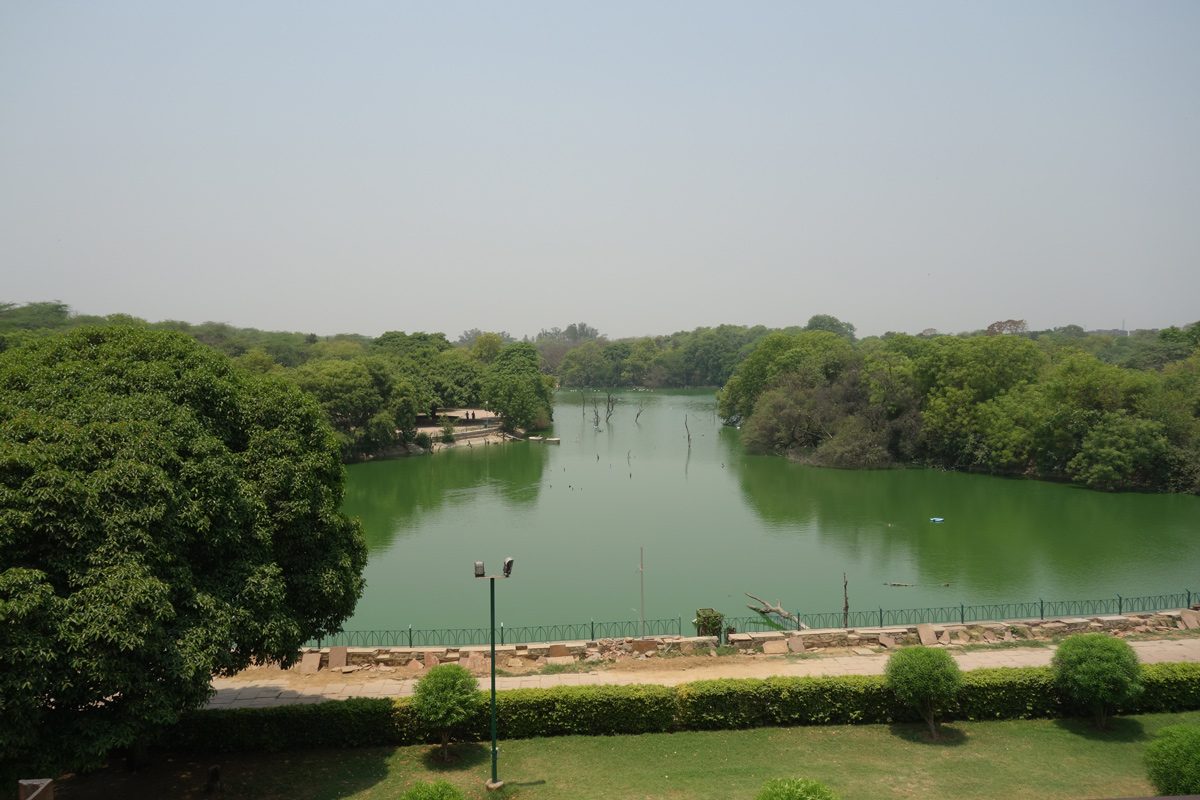 The Serene Hauz Khas Lake, Originally Built as a Reservoir for the Khilji Capital City of Siri
The Serene Hauz Khas Lake, Originally Built as a Reservoir for the Khilji Capital City of Siri
Many of Indian history’s biggest personalities have stamped on these grounds. Alauddin Khilji built the water tank as early as 1296 for his nearby capital of Siri. The dreaded Mongol warlord Timur “the lame” camped here and used these buildings in 1398 as he brutally sacked Delhi, killing hundreds of its residents. And, Feroz Shah Tughlaq, the Delhi Sultanate’s longest-reigning monarch, built a madrassa and his tomb here close to the soothing waters and cool air of the lake alongside.
But, Hauz Khas’ greatest claim to fame was the Firuz Shahi Madrassa that thrived here in the fourteenth century. It was a renowned center of learning, attracting teachers and students from far away countries as well as an important cog in the running of the Delhi sultanate.
Dozens of students from this madrassa filled the administrative needs of growing Sultanate machinery, becoming qadis (judges) in different cities, rasuldars (chamberlains) for managing royal households, and assistants to viziers in government.
And, it was also on these grounds that a board of scholars from around the world formalized the Fatwa-i-Tatarkhani, considered for many centuries to be the leading encyclopedia on fiqh, or Islamic law.
Today, as I stepped through the medieval arches of the Hauz Khas complex, the first monuments I saw were small octagonal and square tombs set on a neat lawn. These tombs belonged to past teachers of the madrassa and were built open-sided with shallow graves at the center for encouraging the madrassa students to sit close to their departed teachers. Even today, in a unique link with our past history, college students from Delhi were using these structures in exactly that way.
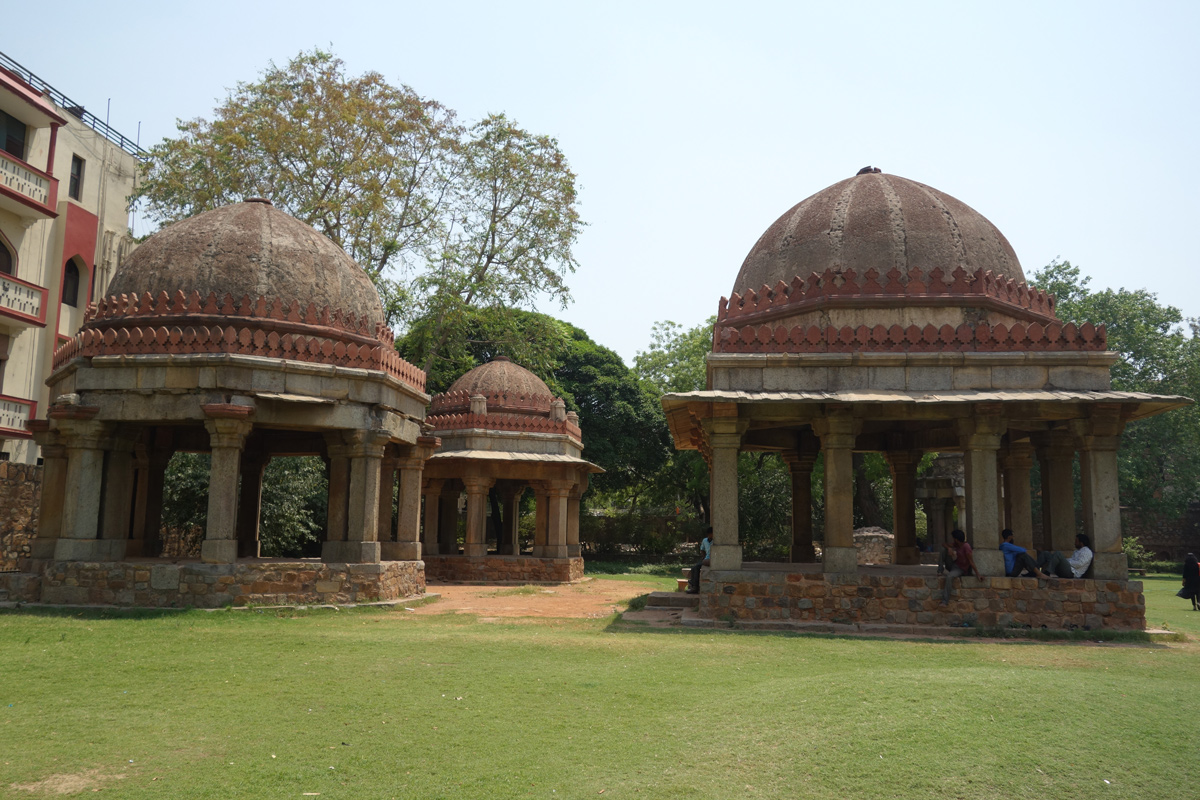 Tombs of Past Madrassa Teachers are a Cool Retreat to Sit in and Contemplate
Tombs of Past Madrassa Teachers are a Cool Retreat to Sit in and Contemplate
Hauz Khas’ central feature is the big water reservoir from which it gets its name. “Hauz” means water tank and “Khas” means royal. Alauddin Khilji had built this tank to provide water for his capital city of Siri. But, once he died and the Khilji dynasty got replaced by the Tughlaqs, Hauz Khas was abandoned in favour of the other capitals that the Tughlaq’s built. It was not till half a century later that Feroz Shah Tughlaq had this site de-silted and restored, for building a famous madrassa and his own mausoleum.
It doesn’t take much to appreciate why Feroz Shah so loved this place. Though my visit was in peak summer with temperatures in excess of forty degrees, the fresh breeze coming off the emerald green waters of Alauddin Khilji’s tank kept the atmosphere cool and pleasant.
The first of the madrassa structures I examined was a three-domed building which historians believe was an assembly room for larger classes, much like college auditoriums of today.
Unsurprisingly, it was full Hindu of architectural elements. The pillars were square-shaped in typical Hindu temple style, and a decorative lotus – the most classical of Hindu designs – adorned the top of the dome. This was not unusual for the Sultanate era, with its close mélange of different faiths.
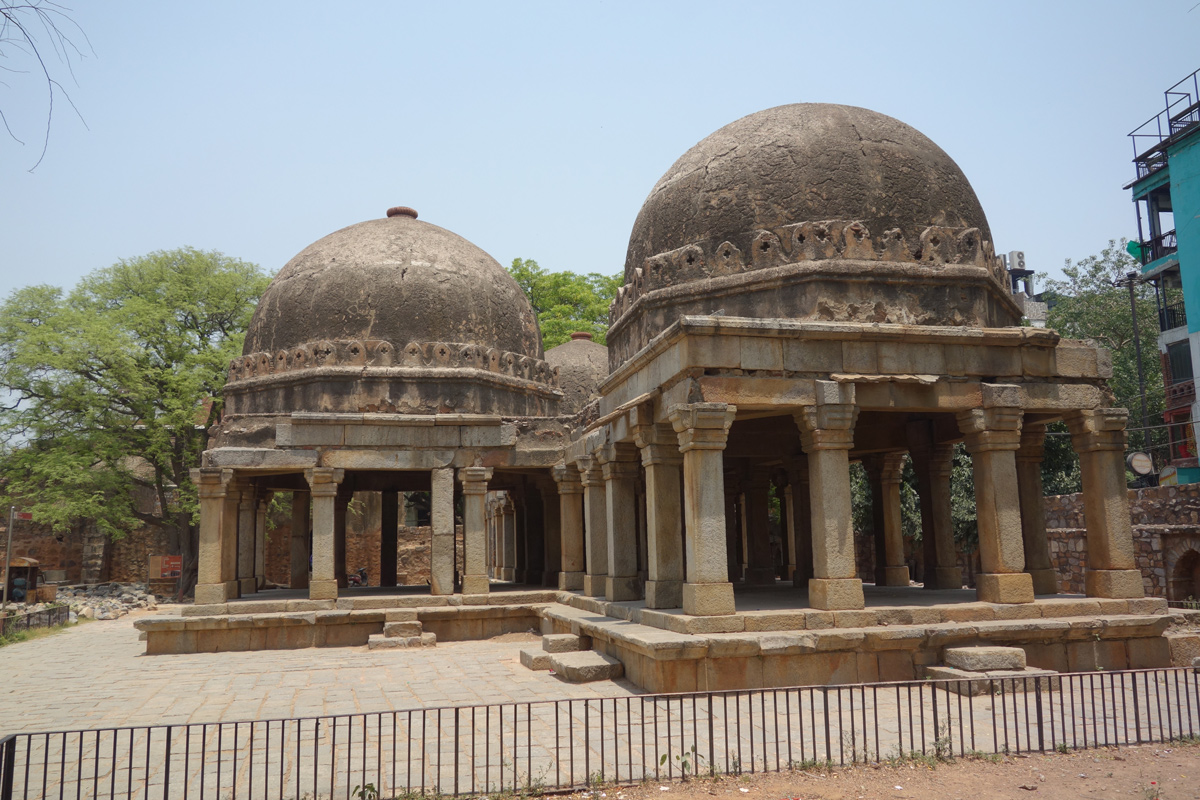 The Three-Domed Building was used like a College Auditorium for Larger Student Classes, and has Many Hindu Architectural features
The Three-Domed Building was used like a College Auditorium for Larger Student Classes, and has Many Hindu Architectural features
The Firuz Shahi Madrassa had been built L-shaped, with Feroz Shah’s tomb as the pivot between the two arms. It was a double-floor structure, with the upper deck housing the classrooms – complete with lovely stone chajjas and balconies for students to enjoy the fresh breeze – and the lower floor the student dormitories.
I descended the steep steps to the lower level, intrigued by how the madrassa students’ would have lived. The layout of a dormitory has not changed in centuries, and these living quarters were arranged in exactly the same way as any college hostel of today; a long and straight corridor, lined with fourteen identical student lodgings in a row.
I entered one of the rooms, trying to re-live a madrassa scholar’s life. The rooms were tiny, with just enough space for a rolled-out mattress on the floor. There were niches on the walls for the storage of books and personal things, and an arched opening above the door to let in light.
But, making up for the cramped quarters was a view to die for. These rooms looked directly on to the glistening waters of the Hauz-i-Alai, with fluffy white swans swimming lazily on its surface. Had I been a student here, this would have been my license for day-dreaming. No chance of concentrating on studies!
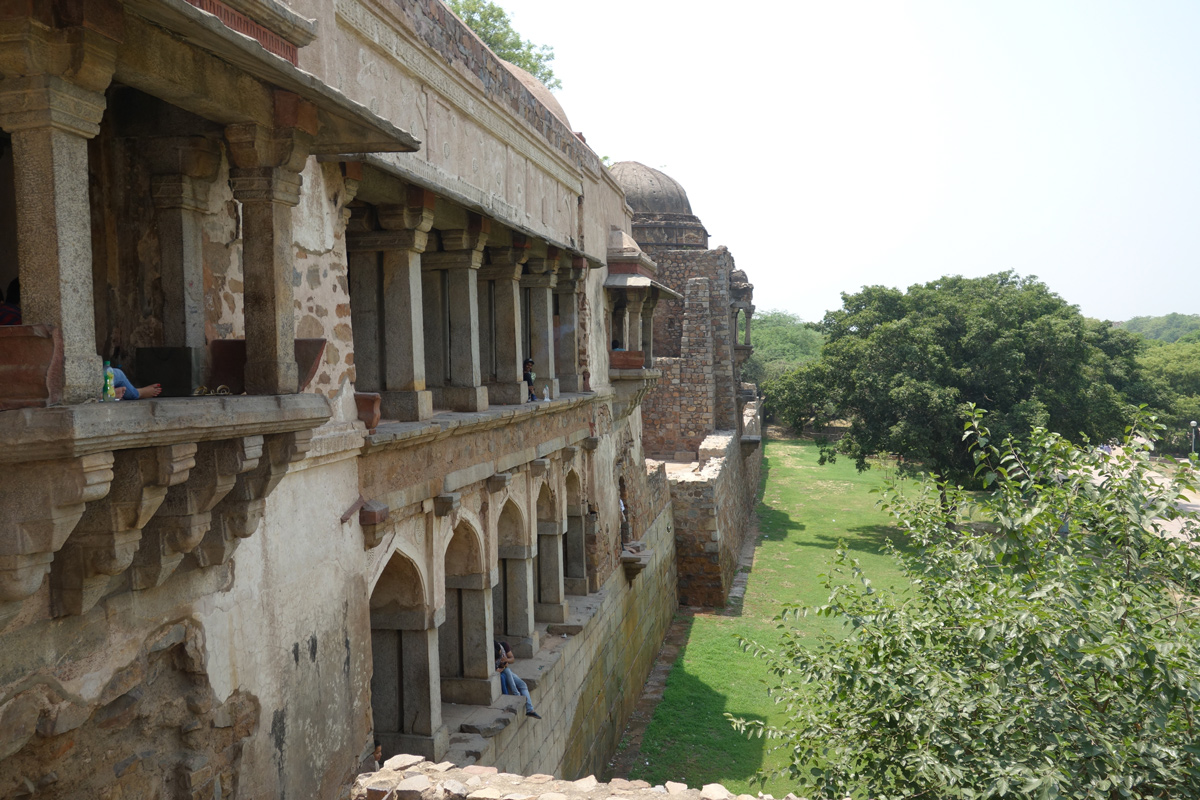 The Double Story Western Wing of the Madrassa; Classrooms on the Upper Floor and the Students’ Dormitory Below
The Double Story Western Wing of the Madrassa; Classrooms on the Upper Floor and the Students’ Dormitory Below The Student’s Dormitory Corridor, With Rooms Overlooking the Lake
The Student’s Dormitory Corridor, With Rooms Overlooking the Lake
Feroz Shah Tughaq’s charismatic tomb is a highlight of the Hauz Khas visit. It is approached via a veranda that is ringed with a most special stone fence. If you take some time to examine this fence, you will notice that the screen is clearly inspired by the famous Sanhci Stupa, one of India’s earliest Buddhist prototypes.
We know that Feroz Shah had designed this mausoleum during his own lifetime. Did he deliberately want to make this connection? If so, it would be yet another noticeable example of the composite culture that typified the sultanate era.
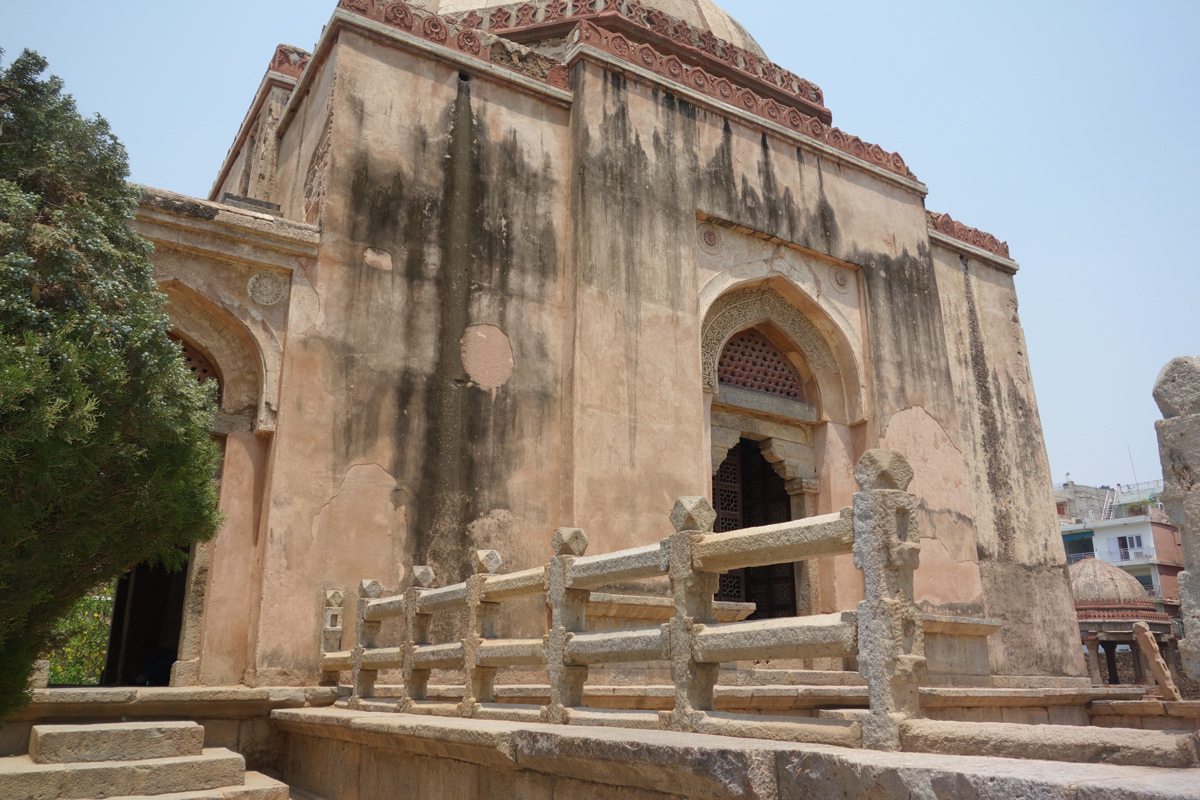 Feroz Shah’s Tomb with the Sanchi Stupa Inspired Stone Railings in the Foreground
Feroz Shah’s Tomb with the Sanchi Stupa Inspired Stone Railings in the Foreground
I entered the small doorway of Feroz Shah’s tomb. Its thick stone walls immediately locked out the searing summer heat, embracing me in its cool and hushed interior. A thin stream of sunshine flowed through the carved jali door, casting a soft dappled light on the ancient walls.
There were four graves in the tomb, all of them male graves. Sultan Feroz Shah Tughlaq was in the center, while the others around him were his son and grandsons. Directly above the crypt, the muted light illuminated a dome decorated with delicate circular designs of Koranic verses.
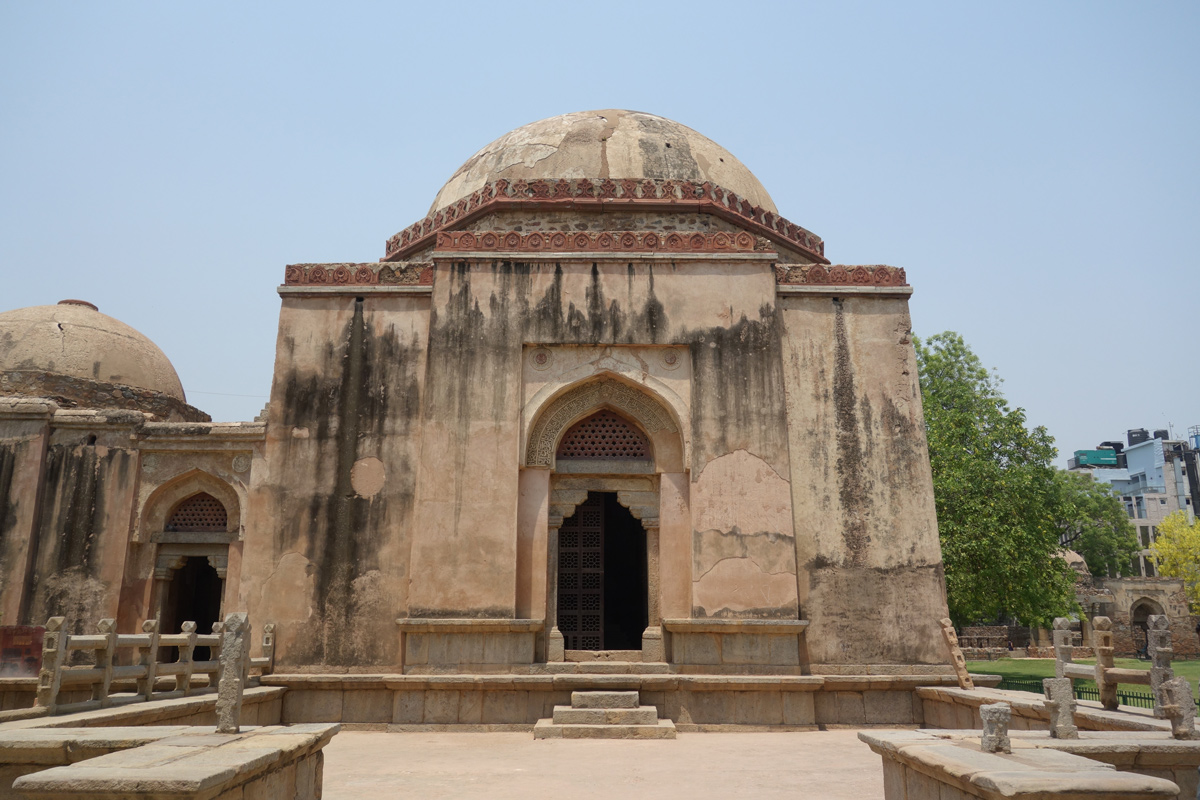 The Small Doorway to Feroz Shah’s Distinctive Tomb, built by Himself During his Lifetime
The Small Doorway to Feroz Shah’s Distinctive Tomb, built by Himself During his Lifetime
In front of me lay Feroz Shah Tughlaq, a monarch who had ruled the Delhi Sultanate for thirty-seven long years and commanded a vast empire which had stretched from Afghanistan to Gujarat to Bengal to the Deccan.
Feroz Shah was eighty-three when his body was lowered in to this grave. History remembers him as one of the more enlightened kings to have ruled Delhi, mature and inclusive in his approach, and a superb builder who has left us a legacy of wonderful monuments, many of which are still enjoyed by Delhites today.
 The Inside Ceiling of the Dome, with Beautiful Koranic Inscriptions
The Inside Ceiling of the Dome, with Beautiful Koranic Inscriptions 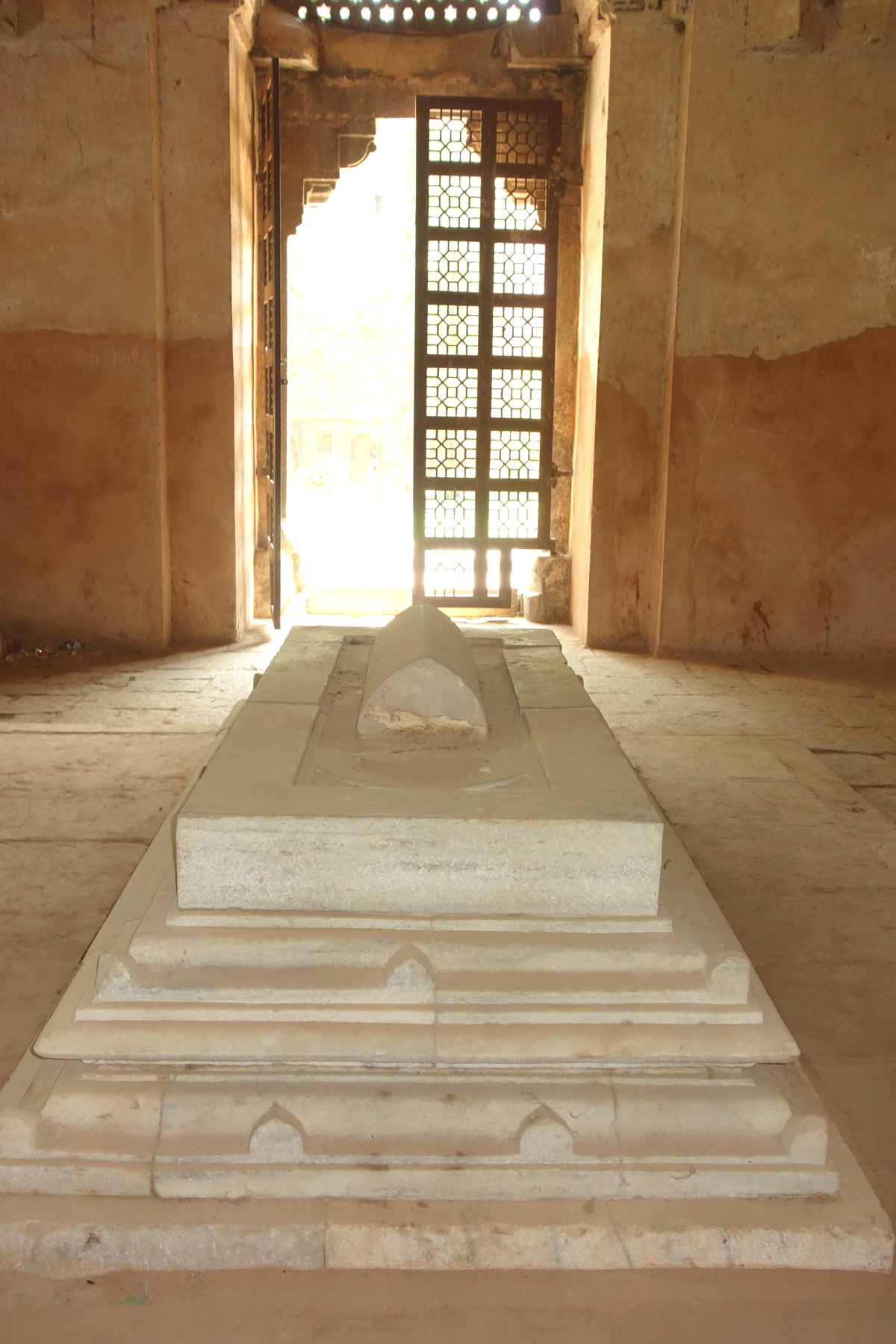 Quiet Rests the Atmospheric Grave of Feroz Shah Tughlaq
Quiet Rests the Atmospheric Grave of Feroz Shah Tughlaq
I sat alone in the cool stillness beside Feroz Shah’s tomb, while the hot sun burned up the lawn outside. All of a sudden, an azaan sounded from a nearby mosque. I let the soft tones wash over me, enjoying the magic of the moment. Me and the Sultan were alone for now, one with history.
The Master-Builder of His Time…Getting to know Feroz Shah Tughlaq
Feroz Shah Tughlaq became Sultan in 1351, succeeding his eccentric cousin Muhammad Bin Tughlaq.
The ill-fated Muhammad had died in battle in Sind and was survived by two daughters. With no male heir, the nobles of the court acted quickly for fear of chaos and offered the throne to Feroz Shah, who was Muhammad’s first cousin and the closest male relative.
It turned out a wise choice. Feroz Shah was a mature forty-six years when he ascended the throne and already well versed with the affairs of state. He could quickly apply the healing touch to his deceased cousin’s hated policies “like that…between a pitch-dark cyclonic night and a calm and clear dawn”.
One of Feroz’s first acts as sultan was seeking forgiveness on behalf of his predecessor. He contacted the heirs of those killed or mutilated on the orders of Muhammad Bin Tughlaq and appeased them with gifts, requesting deeds declaring their satisfaction which he had attested.
He then put these deeds in a chest, “…which was placed…at the head of the tomb of the late sultan, in the hope that God in his great clemency would show mercy to my late friend and patron”.
Feroz was of mixed parentage, and perhaps this is one reason for his inclusive character. His mother Bibi Nala was the Hindu Jat daughter of Rana Mall Bhatti of Dipalpur (now in Pakistan Punjab), and his father was Malik Rajab, the younger brother of Ghiasuddin Tuglaq who had founded the Tughlaq dynasty.
One assumes a broad-minded upbringing influenced Feroz’s personality, making him respect differences and preferring conciliation over confrontation. Because of this, his reign was relatively friction-free and regarded as the golden age of the Delhi Sultanate, specially in terms of contentment of the people “…All men, high and low, bond and free, lived happily and free from care…Things were plentiful and cheap, and the people were well to do….”.
Feroz Shah had a massive appetite for building and preserving. His legacy includes restoring the top two floors of Qutub Minar when damaged by lightening in 1368, re-building Hauz Khas and added a famous madrassa to it, founding new cities like Hissar and Jaunpur and constructing a system of canals that is still in use today.
He built a new capital Feroz Shah Kotla, for which he carefully transported two Ashoka pillars from Meerut and Punjab, for use as prominent landmarks.
These public works spurred economic growth in the sultanate, which Feroz further enabled by introducing small denomination coins broadening the everyday market activities in his bazaars.
There were also some downsides to his rule. Some attempts at conciliation by him, had looked practical at the time but ended up weakening the Sultanate. To suppress rebellions and get the nobility and army on to his side, Feroz decided to make many positions hereditary and even a soldier could nominate who he wanted to serve after him. But, with birth the qualification for government jobs instead of competence, governance got weakened over time.
And, there is one more criticism. Despite a liberal Hindu-Muslim parentage, Feroz did pander to fundamentalism when it suited him. He tightened the laws on Jizya tax payable by non-Muslims (for the Muslims, he enforced a very strict zakat), and he persecuted Shias living in his kingdom, punishing their leaders.
But overall, history judges Feroz Shah kindly. He is seen as lenient and generous, providing his people a stable prosperous environment and ruling without ego, unlike his predecessor who “wanted the world to adjust to him…Feroz adjusted himself to the world”.
Medieval Graffiti on Hauz Khas Walls
The Babur Nama – memoires of Emperor Babur which he had penned himself – has an interesting comment on some unwelcome graffiti on Hauz Khas’ walls.
After Babur had marched triumphantly in to Delhi, following factory at the Battle of Panipat overthrowing the Lodi dynasty, he decided to bed down in India and establish the Mughal dynasty.
But some of his closest generals were against this idea, disliking the heat and dust of India and wanting instead to head back to Kabul.
Babur writes; “when I heard of this unsteadiness amongst my people, I summoned all the begs and took counsel (August, 1526). Said I “there is no supremacy and grip on this world without means and resources; without land and retainers sovereignty and command are impossible. By the labors of several years, by encountering hardship, by long travel, by flinging myself and the army in to battle, and by deadly slaughter, we, through God’s grace, beat these masses of enemies in order that we might take their broad lands…”
“…And now what force compels us, what necessity has arisen that we should, without cause, abandon countries taken at such risk of life? Was it for us to remain in Kabul, the sport of harsh poverty? Henceforth, let no well-wisher of mine speak of such things! But let not those turn back from going who, weak in strong persistence, have set their faces to depart!”
Despite this stirring appeal, one of Babur’s closest comrades Khwaja Kalan decided to leave. The parting was amicable, with Babur handing his friend gifts and retainers and allowing him his way. Khwaja Kalan had set up home here in Hauz Khas, and when he left, he inscribed this couplet on the walls of his Hauz Khas house :
“If safe and sound I cross the Sind,
Blacken my face ere I wish for Hind”
Blacken my face ere I wish for Hind”
Babur could not see the humor; ”it was ill-mannered of him to write up and compose this partly-jesting verse while I still stayed in Hind. If his departure caused me one vexation, such a jest doubled it. I composed the following verse, wrote it down, and sent it to him :
“Give a hundred thanks Babur, that the generous Pardoner
Has given thee Sind and Hind and many a kingdom
If thou (ie, the Khwaja) have not the strength for their heats
If thou say “let me see the cold side”, Ghazni is there”
Has given thee Sind and Hind and many a kingdom
If thou (ie, the Khwaja) have not the strength for their heats
If thou say “let me see the cold side”, Ghazni is there”
* Babur Nama translation Vol1 and 2, by Annette Susannah Beveridge (Page 525-526)
The Importance of Being the Firuz Shahi Madrassa
Baghdad was the capital of the Abbasid Caliphate and the cultural heart of Islam in the 1200s. The city carried enormous prestige as a center of science and culture, and famously hosted the Bayt-al-Hilma (House of Wisdom) where scholars from around the world worked on new discoveries in mathematics, astronomy, medicine and chemistry.
This high culture was wiped out in a single stroke in 1258, when Hulagu Khan – the grandson of Chengiz Khan – and his fierce Mongols brutally attacked Baghdad and razed its fine libraries and palaces including the Bayt-al-Hilma.
It is said the river Tigris turned black with the ink of destroyed books and red with the blood of killed citizens.
In the vacuum that was created, Delhi became an increasingly important center for higher education. The Firuz Shahi Madrassa at Hauz Khas developed a reputation for knowledge, attracting top scholars from around the world.
But the fickle fingers of fate had the same end in store for the Hauz Khas madrassa.
Yet another Mongol, who also invoked the legacy of Chengiz Khan, Timur “the lame” (Tamerlane) plundered Delhi in 1398, killing hundreds of residents and leaving the city in smoking ruins. Timur camped right here at Hauz Khas during his Delhi raids, and he mentions these buildings with admiration, including the water reservoir “…more than a bow’s shot long”.
How to get here:
-
- From Aurobindo Marg turn on to Hauz Khas Village Road, which ends directly at the Hauz Khas Complex gates. You may want to take an auto, as the distance is about two Kilometers.
- Along the way you will pass some lovely buildings, including the mysterious looking Sakri Gumti gateway to your right, and the white-painted Jagannath Temple to the left.
- The road then enters Hauz Khas Village, lined with restaurants and bars. Straight ahead is the stone-arch entrance for the Hauz Khas Complex.
Information:
- The Hauz Khas Complex is open daily, 10am-6pm.
Sources:
- Spear, Percival. Delhi Its Monuments and History. Third edition – updated and annotated by Narayani Gupta and Laura Sykes (Delhi; Oxford India Paperbacks 1994)
- Eraly, Abraham. The Age of Wrath. A History of the Delhi Sultanate (published by Penguin Books India 2014)
- Annette Susannah Beveridge. Babur Nama translation Vol1 and Vol2. (Published by Oriental Books, New Delhi)
- Kumari, Savita. Tombs of Delhi, Sultanate Period (Published by Bharatiya Kala Prakashan, Delhi, 2006)
- Delhi The Built Heritage : A Listing, Vol. 2 (published by INTACH Delhi Chapter ,1999)

